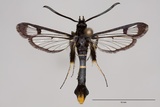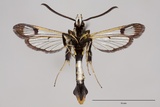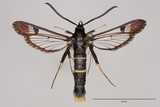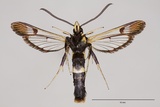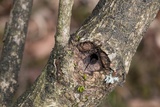Synanthedon andrenaeformis (Laspeyres, 1801) Species
Last modified: May 14, 2024, 10:28 a.m.
S. andrenaeformis is a local species in Belgium, only known from the southern provinces where it seems to be concentrated in limestone biotopes.
Details
- Classification
- Family: Sesiidae > Subfamily: Sesiinae > Tribus: Synanthedonini > Genus: Synanthedon > Species: Synanthedon andrenaeformis
- Vernacular names
- Sneeuwbalwespvlinder (NL), Orange-tailed Clearwing (EN), Sésie de la Viorne (FR), Schneeball-Glasflügler (DE)
- First mention in Belgium
- Lambillion L.-J. 1900–1913. Catalogue des Lépidoptères de Belgique. — Revue mensuelle de la Société entomologique namuroise Supplément: 1–464. On page 392.
- Status
-
Native
Distribution
Imago
S. andrenaeformis is a medium sized species (16–26mm) with a dark brown or black appearance. The male has a typical and notable arrow-shaped anal tuft which is black with a conspicuous yellow centre. A considerable part of the ventral side of the abdomen is pure white. The dorsal side has a narrow yellow band just behind the thorax and a broader yellow band in the middle of the abdomen. The female lacks the striking and well developed arrow-shaped anal tuft and the white colouration of the ventral side of the abdomen. Instead, the broad yellow band is also present at this ventral side.
The males are attracted in the late forenoon (eg. 10h–12h) to the pheromone originally developed for S. vespiformis. In early afternoon (eg. 14h–15h) there is sometimes a second but weaker attraction-period.
They are also attracted to the pheromone originally developed for S. vespiformis.
Egg
The elliptical egg is dark-brown.
Caterpillar
The larva is off-white and has a brownish black head. As in all Sesiidae, the prolegs have a double wreath of crochets. The prothoracic shield is weakly sclerotised and uniformly coloured.
Mine
The young larva lives initially in a mine under the bark and, later on, it constructs a gallery in the central marrow channel of the stem (mostly upwards).
Bionomics
Initially, the young larva lives in a mine under the bark and, later on, it constructs a gallery of 25–40 mm in the central pith channel of the stem (mostly upwards) and spins a loose hibernaculum to overwinter. In the following spring, the larva enlarges the gallery to 60–80 mm and before the second wintering, prepares the future exit hole. The caterpillar cuts a circle in the bark that is considerably larger than the exit hole and is covered by a cap of spun small plant particles. Mostly this cap still carries the cut-out bark lid but (very) often this lid, drying out and shrinking during winter, falls off. Then, the spun seal of the exit hole becomes clearly visible. The second hibernation also takes place in a loose cocoon-like web. Pupation follows, generally head down, in May of the following spring in a loose cocoon.
Flight periods
The adults fly from mid-May towards mid-July but the main flight period is June.
Observed on
- Host plant (species):
- Viburnum lantana and Viburnum opulus
The larva bores inside the stem of Viburnum lantana and, less frequent, also in Viburnum opulus.
